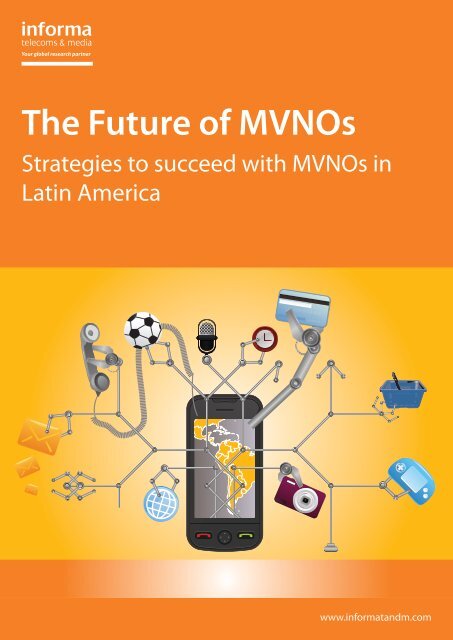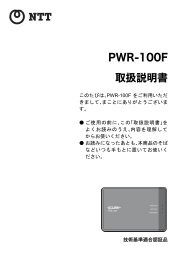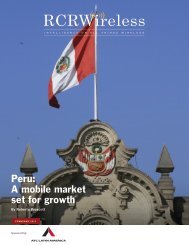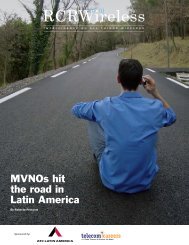You also want an ePaper? Increase the reach of your titles
YUMPU automatically turns print PDFs into web optimized ePapers that Google loves.
Your global research partner<br />
<strong>The</strong> <strong>Future</strong> <strong>of</strong> <strong><strong>MVNO</strong>s</strong><br />
Strategies to succeed with <strong><strong>MVNO</strong>s</strong> in<br />
Latin America<br />
www.informatandm.com
© Informa UK Limited 2012. All rights reserved.<br />
<strong>The</strong> contents <strong>of</strong> this publication are protected by international copyright laws, database rights and other intellectual property rights. <strong>The</strong> owner <strong>of</strong> these rights is Informa UK Limited,<br />
our affiliates or other third party licensors. All product and company names and logos contained within or appearing on this publication are the trade marks, service marks or trading<br />
names <strong>of</strong> their respective owners, including Informa UK Limited. This publication may not be:-<br />
(a) copied or reproduced; or<br />
(b) lent, resold, hired out or otherwise circulated in any way or form without the prior permission <strong>of</strong> Informa UK Limited.<br />
Whilst reasonable efforts have been made to ensure that the information and content <strong>of</strong> this publication was correct as at the date <strong>of</strong> first publication, neither Informa UK Limited nor<br />
any person engaged or employed by Informa UK Limited accepts any liability for any errors, omissions or other inaccuracies.<br />
Readers should independently verify any facts and figures as no liability can be accepted in this regard - readers assume full responsibility and risk accordingly for their use <strong>of</strong> such<br />
information and content.<br />
Any views and/or opinions expressed in this publication by individual authors or contributors are their personal views and/or opinions and do not necessarily reflect the views and/or<br />
opinions <strong>of</strong> Informa UK Limited.<br />
2<br />
© 2012 Informa UK Ltd. All rights reserved. www.informatandm.com
Contents<br />
Understanding the global picture ............................................................................. 4<br />
<strong>The</strong> outlook for <strong><strong>MVNO</strong>s</strong> in Latin America .................................................................. 4<br />
Opportunity for <strong>MVNO</strong>-led pricing arbitration is low.................................................. 5<br />
Triple play will remain a major <strong>MVNO</strong> driver ............................................................ 6<br />
Beyond the “telecoms <strong>MVNO</strong>”: <strong>The</strong> retailer, the financial and the youth <strong>MVNO</strong>....... 7<br />
<strong>The</strong> <strong>MVNO</strong> quadrant: Global and regional case studies.............................................. 8<br />
Global <strong>MVNO</strong> survey .................................................................................................... 10<br />
Working with Informa<br />
Informa Telecoms & Media’s strategic insights, key market data and forecasts have led the market for more than 25 years. We<br />
have 65 analysts in nine research <strong>of</strong>fices <strong>of</strong>fering pragmatic and actionable advice to the leading global players in the telecoms<br />
and media sector. Our clients represent all parts <strong>of</strong> the value chain, from telecoms operators to pay-TV providers, from content<br />
providers to device manufacturers. Our syndicated research and comprehensive databases provide vital data and analysis<br />
focusing on the global telecoms and media markets, and are widely used and valued by industry pr<strong>of</strong>essionals and thought<br />
leaders. We also provide a range <strong>of</strong> consultancy and bespoke research services, including white papers, webinars, strategy<br />
sessions and executive presentations.<br />
For more details on Informa Telecoms & Media and how we can help your company identify future trends and<br />
opportunities, please contact Marco Esposito, marco.esposito@informa.com or +44 (0) 7884 400 999.<br />
© 2012 Informa UK Ltd. All rights reserved. www.informatandm.com 3
Understanding the<br />
global picture<br />
A new phase <strong>of</strong> <strong>MVNO</strong> expansion is beginning<br />
<strong>MVNO</strong> markets have gone through various stages<br />
<strong>of</strong> development in recent years. Since the first<br />
introduction <strong>of</strong> <strong><strong>MVNO</strong>s</strong> in the 1990s and the second<br />
wave <strong>of</strong> proliferation in the mid-2000s, the number <strong>of</strong><br />
players has increased and contracted in cycles. <strong>The</strong><br />
attitude <strong>of</strong> mobile operators has gone through some<br />
radical changes: Initially, the mobile operators fought<br />
against <strong>MVNO</strong> legislation and the <strong><strong>MVNO</strong>s</strong> themselves;<br />
then they accepted the existence <strong>of</strong> <strong>MVNO</strong> players; and<br />
then they started eagerly seeking new <strong>MVNO</strong> partners<br />
and developing aggressive wholesale strategies.<br />
Informa believes that a rejuvenated phase <strong>of</strong> expansion<br />
is beginning. In markets where <strong><strong>MVNO</strong>s</strong> have traditionally<br />
played a role, typically Europe, Asia Pacific and<br />
North America, <strong>MVNO</strong> players are consolidating and<br />
internationalizing but, despite this, they are continuing<br />
to grow in many segments.<br />
<strong>The</strong>re are still many market segments untapped by the<br />
mobile network operators that are being addressed by<br />
<strong><strong>MVNO</strong>s</strong> – these include the ethnic markets, data-only<br />
connectivity, and community-led and retailer-owned<br />
<strong><strong>MVNO</strong>s</strong> – and there is also a strong push from mobile<br />
operators wanting to increase their share <strong>of</strong> mobile<br />
wholesale revenues. Informa believes that virtually every<br />
mobile market has the potential to benefit from <strong><strong>MVNO</strong>s</strong>,<br />
and every mobile operator can derive an advantage from<br />
<strong><strong>MVNO</strong>s</strong>.<br />
<strong>The</strong> global <strong>MVNO</strong> market will reach 186 million<br />
subscriptions by the end <strong>of</strong> 2015. Although North<br />
Fig. 1: Global, number <strong>of</strong> <strong>MVNO</strong> launches, by region,<br />
1991-2010<br />
Western Europe<br />
46%<br />
Source: Informa Telecoms & Media<br />
Asia Pacific<br />
12%<br />
Eastern Europe<br />
14%<br />
Africa<br />
2%<br />
Middle East<br />
2%<br />
North America<br />
21%<br />
Latin America<br />
3%<br />
America and Western Europe will still account for the<br />
vast majority (see fig. 1), new markets are developing<br />
– Latin America, Africa, Middle East and Asia are all<br />
experiencing great <strong>MVNO</strong> interest.<br />
When their <strong>of</strong>fering is appropriately designed, <strong><strong>MVNO</strong>s</strong><br />
can be a win-win-win market: host operators can reach<br />
additional – actual or potential – customers in a way that is<br />
more efficient compared with what their own retail networks<br />
can do; wholesale partners can enrich their existing<br />
nontelecoms services with mobile connectivity, or extend<br />
their brands into the telecoms sector; and customers can<br />
benefit from a more accurately-segmented <strong>of</strong>fering.<br />
However, the reality is that, in the vast majority <strong>of</strong> mobile<br />
markets, <strong><strong>MVNO</strong>s</strong> do not exist at all, while in some markets,<br />
<strong>MVNO</strong> activity is still in an embryonic phase. In developed<br />
<strong>MVNO</strong> markets, the <strong><strong>MVNO</strong>s</strong> can account for approximately<br />
15-20% <strong>of</strong> the customer base, a level that is generally<br />
considered physiologically sustainable.<br />
<strong>The</strong> outlook for <strong><strong>MVNO</strong>s</strong><br />
in Latin America<br />
<strong>The</strong> market is still embryonic, but there is<br />
significant potential for growth<br />
Typically, Latin American <strong><strong>MVNO</strong>s</strong> have been the domain <strong>of</strong><br />
existing telecoms companies keen to <strong>of</strong>fer converged fixed/<br />
mobile bundles. <strong>The</strong> most notable examples include the<br />
ISP Maxcom and the cable player Megacable in Mexico,<br />
ISPs UNE and ETB in Colombia, and Telsur/GTD in Chile.<br />
<strong>The</strong> first nontelecoms <strong><strong>MVNO</strong>s</strong> appeared only in the<br />
second half <strong>of</strong> 2010. Initially, Colombian TV group<br />
RCN launched Uff, an <strong>MVNO</strong> <strong>of</strong>fering cheap longdistance<br />
calls to fixed and mobile numbers in the main<br />
countries where the Colombian expats live. <strong>The</strong>n, in<br />
mid-2011, the region saw the first retailer launch,<br />
when Costa Rican electronics and furniture retailers<br />
Grupo Monge and Casa Blanca introduced Fullmovil.<br />
<strong>The</strong> mobile network operators (MNOs) have finally started<br />
to look with interest at the wholesale model – and the<br />
initial figures are encouraging. For example, Uff in<br />
Colombia is already a sizable <strong>MVNO</strong>, with close to 250,000<br />
subscribers at the end <strong>of</strong> 2011 (see fig. 2).<br />
In Brazil, where formal <strong>MVNO</strong> regulation was passed<br />
in September 2010, the regulator Anatel granted <strong>MVNO</strong><br />
4<br />
© 2012 Informa UK Ltd. All rights reserved. www.informatandm.com
licenses to the insurance company Porto Seguro and<br />
the VoIP provider Sermatel Comercio. Both companies<br />
have teamed up with second-placed operator TIM, which<br />
provides the network infrastructure, and Datora, a<br />
mobile-virtual-network enabler (MVNE). More recently,<br />
Anatel granted the first pure <strong>MVNO</strong> license to the MVNE<br />
Sisteer. Besides TIM, other network operators are looking<br />
with interest at the <strong>MVNO</strong> model, for example, the market<br />
leader Vivo. In March, Vivo announced plans to have at<br />
least two <strong>MVNO</strong> partners by the end <strong>of</strong> 2012. In order<br />
to achieve its objective, the operator created a board<br />
for wholesale and <strong>MVNO</strong> operations and is currently<br />
analyzing proposals from around 30 potential partners.<br />
<strong>The</strong> Latin American <strong>MVNO</strong> market started picking up in<br />
the second half <strong>of</strong> 2011, and the strongest activity was<br />
in Colombia and Chile. In February this year, Chilean<br />
regulator Subtel received 26 license applications from<br />
companies interested in launching <strong>MVNO</strong> operations. In<br />
April, Virgin Mobile Latin America (VMLA) inaugurated<br />
its first <strong>MVNO</strong> in the Andean country, targeting the<br />
youth and “youthful” segments with a simple portfolio <strong>of</strong><br />
prepaid data packages and a small but attractive range<br />
<strong>of</strong> smartphones.<br />
So far, VMLA is the only international group with plans to<br />
launch <strong>MVNO</strong> operations across the region. In addition<br />
to Chile, it plans to launch in Brazil, Colombia, Mexico,<br />
Argentina, Peru, Uruguay and Bolivia. Interestingly,<br />
Colombia is likely to have eight <strong><strong>MVNO</strong>s</strong> and three MNOs<br />
in operation by the end <strong>of</strong> 2012: In addition to the <strong><strong>MVNO</strong>s</strong><br />
already in operation, retailers Exito and Falabella, and<br />
fixed operator Emcali, have also started discussions to<br />
find an MNO partner.<br />
Opportunity for <strong>MVNO</strong>-led<br />
pricing arbitration is low<br />
<strong><strong>MVNO</strong>s</strong> must find ways to <strong>of</strong>fer attractive data<br />
<strong>of</strong>fers – to the right niche and at the right price<br />
In traditional <strong>MVNO</strong> markets, such as Europe, North<br />
America and Asia, <strong><strong>MVNO</strong>s</strong> have historically targeted<br />
the prepaid market with a low-cost proposition and<br />
then tried to attract the more affluent customers.<br />
International experience shows that the wholesale<br />
business can bring MNOs significantly higher EBITDA<br />
margins than retail, by reducing subscriber-acquisition<br />
cost (SAC) while only slightly lowering ARPU. Typically,<br />
a market with comparatively high or very high prices<br />
is more likely to have room for <strong>MVNO</strong>-led price<br />
arbitration. Markets with higher levels <strong>of</strong> churn also<br />
might <strong>of</strong>fer better opportunities for <strong><strong>MVNO</strong>s</strong> because<br />
users are more inclined to switch providers (see fig. 3).<br />
Churn (%)<br />
Fig. 3: Selected countries, blended churn, 3Q10-3Q11<br />
4.0<br />
3.5<br />
3.0<br />
2.5<br />
2.0<br />
1.5<br />
Argentina Brazil Colombia Mexico<br />
France UK US<br />
3Q10<br />
4Q10<br />
1Q11<br />
2Q11<br />
3Q11<br />
Fig. 2: Latin America, selected <strong><strong>MVNO</strong>s</strong>' subscriptions,<br />
4Q10-4Q11<br />
Source: Informa Telecoms & Media<br />
Uff<br />
250<br />
Maxcom<br />
UNE EPM<br />
Telecsa<br />
Given their pricing environments and churn trends,<br />
Brazil, Mexico and Colombia, and to a lesser extent<br />
Argentina, would appear well-suited for additional<br />
Subscriptions (000s)<br />
200<br />
150<br />
100<br />
50<br />
0<br />
4Q10<br />
1Q11<br />
2Q11<br />
3Q11<br />
4Q11<br />
price competition. In all the markets, the lack <strong>of</strong><br />
regulation in mobile termination rates (MTRs) and the<br />
fact that operators have mostly been left to negotiate<br />
MTRs among themselves have resulted in the higher<br />
cost <strong>of</strong> <strong>of</strong>f-net calls. Brazilian rates are also affected<br />
by high telecoms-services taxation and, as a result,<br />
the country has the highest SMS prices in the region.<br />
Promotional activity, primarily the <strong>of</strong>fering <strong>of</strong> cheap<br />
on-net calls, is strong across the region, contributing<br />
Source: Informa Telecoms & Media<br />
to sustained high levels <strong>of</strong> multiple-SIM ownership<br />
and churn.<br />
© 2012 Informa UK Ltd. All rights reserved. www.informatandm.com 5
Informa, however, believes that for Latin American<br />
MNOs the option <strong>of</strong> teaming up with low-cost <strong><strong>MVNO</strong>s</strong><br />
to bring price competition to other MNOs is not<br />
particularly attractive. In the prepaid-dominated Latin<br />
American markets, the potential negative impact <strong>of</strong><br />
low-cost <strong><strong>MVNO</strong>s</strong> on an already flat or declining ARPU<br />
is a major concern for MNOs. Latin American MNOs<br />
will be more interested in teaming up with <strong><strong>MVNO</strong>s</strong><br />
that, although helping improve EBITDA margins, can<br />
also bring additional revenues from unaddressed<br />
niches willing to use incremental airtime and data<br />
services (see fig. 4).<br />
Fig. 4: Selected operators, EBITDA margin, 3Q11<br />
Margin (%)<br />
50<br />
40<br />
30<br />
20<br />
10<br />
0<br />
Movistar<br />
(Argentina)<br />
Claro<br />
(Brazil)<br />
TIM<br />
(Brazil)<br />
Source: Informa Telecoms & Media<br />
Telcel<br />
(Mexico)<br />
Informa also believes that pricing will be crucial to the<br />
success <strong>of</strong> the higher-value data <strong><strong>MVNO</strong>s</strong>. In addition<br />
to the well-known benefits <strong>of</strong> the <strong>MVNO</strong> model,<br />
higher-value data-focused <strong><strong>MVNO</strong>s</strong> can help provide<br />
incremental revenues to <strong>of</strong>fset declining ARPU<br />
levels. Finding the correct pricing levels and models,<br />
however, is a tough task. As in the case <strong>of</strong> Virgin<br />
Mobile in Latin America, data <strong><strong>MVNO</strong>s</strong> will be eager<br />
to add smartphones to their data plans, but without<br />
subsidies it can be challenging to meet customer<br />
demand for the devices at the right price.<br />
At the same time, <strong><strong>MVNO</strong>s</strong> must be able to negotiate<br />
good wholesale rates from MNOs for the data they then<br />
sell at retail. In the retail market, MNOs are moving<br />
away from flat rates and toward models where they<br />
charge by actual data consumption, by time or by access<br />
to selected apps. MNOs themselves are still struggling<br />
to find efficient ways to price data services in the retail<br />
market. When it comes time to negotiate wholesale<br />
data prices, <strong><strong>MVNO</strong>s</strong> face the risk <strong>of</strong> remaining stuck<br />
with unfavorable conditions, which could ultimately<br />
jeopardize their business model.<br />
Orange<br />
(France)<br />
Vodafone<br />
(UK)<br />
AT&T<br />
(US)<br />
Triple play will remain a<br />
major <strong>MVNO</strong> driver<br />
Challenging fixed-line operators and ISPs<br />
should exploit the <strong>MVNO</strong> model to develop more<br />
competitive <strong>of</strong>ferings<br />
Most <strong>of</strong> the early Latin American <strong><strong>MVNO</strong>s</strong> have been driven<br />
by the opportunity to <strong>of</strong>fer fixed/mobile bundles, especially<br />
in the most concentrated markets, such as Mexico and<br />
Colombia (see fig. 5). It is not a coincidence that despite<br />
the absence <strong>of</strong> a full regulatory framework, both Movistar<br />
in Mexico and Tigo in Colombia have taken advantage <strong>of</strong><br />
existing rules allowing telecoms services to be resold to<br />
build <strong>MVNO</strong> partnerships with ISPs and cable players. To<br />
erode shares <strong>of</strong> strong competitors in their respective<br />
markets, Movistar and Tigo have established <strong><strong>MVNO</strong>s</strong><br />
with fixed operators looking to add value to their bundles<br />
<strong>of</strong> voice, TV and Internet service by including mobility.<br />
Movistar was the first to pursue this strategy, when it<br />
teamed up with Maxcom at the start <strong>of</strong> 2008. Similarly, Tigo<br />
in Colombia has partnered with ISPs UNE EPM and ETB to<br />
<strong>of</strong>fer mobile broadband services to contract customers.<br />
For the foreseeable future, Informa expects alternative<br />
ISPs, especially in the most unbalanced fixed-line<br />
markets, to retain a strong interest in the <strong>MVNO</strong><br />
model with the aim <strong>of</strong> increasing customer loyalty<br />
Fig. 5: Brazil, Argentina, Colombia, Mexico, market<br />
share and concentration, 3Q11<br />
100<br />
90<br />
80<br />
70<br />
60<br />
50<br />
40<br />
30<br />
20<br />
10<br />
0<br />
Market share (%)<br />
America Movil Telefonica Millicom Telecom Italia<br />
Telecom Personal Oi Others*<br />
Brazil<br />
Argentina<br />
Concentration: Herfindahl index<br />
Colombia<br />
Mexico<br />
0.25 0.32 0.51 0.54<br />
Notes: <strong>The</strong> Herfindahl index is defined by the sum <strong>of</strong> the squares <strong>of</strong> the<br />
market shares <strong>of</strong> all firms in the market, where the market shares are<br />
expressed as fractions. An index below 0.01 indicates a highly competitive<br />
market. An index below 0.15 indicates an unconcentrated market. An<br />
index between 0.15 and 0.25 indicates moderate concentration. An index<br />
above 0.25 indicates high concentration. *Nextel, CTBC and Sercomtel In<br />
Brazil; Iusacell and Nextel in Mexico; and Nextel in Argentina. Telecom<br />
Italia owns 22.9% <strong>of</strong> Telecom Personal in Argentina.<br />
Source: Informa Telecoms & Media<br />
6<br />
© 2012 Informa UK Ltd. All rights reserved. www.informatandm.com
and reinforcing their <strong>of</strong>fering by bundling products.<br />
With their knowledge <strong>of</strong> and expertise in the telecoms<br />
business, fixed-line players and ISPs remain the most<br />
likely candidates to buy into the <strong>MVNO</strong> model at the<br />
early stages <strong>of</strong> its development.<br />
It is no coincidence that the first cable operator to<br />
launch an <strong>MVNO</strong> was Megacable in Mexico and that the<br />
challenger fixed-line operator Axtel is also said to be<br />
close to launching an <strong>MVNO</strong> there. <strong>The</strong> opportunity is<br />
comparatively weaker in countries where the broadband<br />
market is more competitive, such as Brazil, and the main<br />
existing mobile operators can develop converged <strong>of</strong>fers<br />
through partnering with their own fixed-line counterparts.<br />
In markets like Brazil, it is the nontelecoms companies<br />
that are expected to be major players in the <strong>MVNO</strong><br />
business, starting with retailers and financial institutions.<br />
Beyond the “telecoms<br />
<strong>MVNO</strong>”: <strong>The</strong> retailer, the<br />
financial and the youth <strong>MVNO</strong><br />
Retailers can help MNOs increase loyalty and<br />
reduce churn, but negotiations with MNOs will<br />
be tough<br />
Beyond the “telecoms <strong>MVNO</strong>” (e.g., an existing fixed-line<br />
telecoms player with an <strong>MVNO</strong> operation), retailers and<br />
financial institutions have been and remain among the<br />
strongest candidates to become <strong><strong>MVNO</strong>s</strong> in Latin America<br />
(see fig. 6). Large and mass-market retailers are<br />
already key players in the value chain, since they take<br />
Fig. 6: Brazil, companies interested in launching an <strong>MVNO</strong><br />
Telecoms<br />
Financial<br />
GVT, Lebara, Virgin Mobile<br />
Banco do Brasil, Banco Real<br />
Santander, Itau, HSBC<br />
the largest slice <strong>of</strong> handset sales, especially for prepaid<br />
users. <strong>The</strong> combination <strong>of</strong> a strong brand and a larger<br />
and far-reaching retail network are the key benefits<br />
retailer <strong><strong>MVNO</strong>s</strong> could <strong>of</strong>fer MNOs.<br />
Despite the clear benefits that retailers could bring to<br />
MNOs, only a handful <strong>of</strong> international retailers, such as<br />
supermarket chains Tesco in the UK and Aldi in Germany,<br />
have launched <strong><strong>MVNO</strong>s</strong>. Retailers are typically focused on<br />
volumes, have low EBITDA margins and are used to having<br />
strong negotiating and bargaining power with suppliers,<br />
factors that can prove to be especially challenging in<br />
their negotiations with MNOs. Furthermore, retailers will<br />
naturally target the mass market, which for MNOs raises<br />
the risk <strong>of</strong> market-share cannibalization, especially in the<br />
prepaid-dominated Latin American markets.<br />
Even so, the retailer model does have potential in the<br />
region, starting in the geographically larger countries,<br />
such as Brazil, Mexico and Argentina, where it is more<br />
challenging for MNOs to develop far-reaching retail<br />
networks. In addition, retailers can help MNOs increase<br />
loyalty and reduce churn by using their customer-loyalty<br />
experience to <strong>of</strong>fer discount and loyalty cards and to<br />
<strong>of</strong>fer leasing programs for device purchases. As the<br />
VAS market develops, the retail <strong>MVNO</strong> is also in a good<br />
position to develop mobile commerce.<br />
<strong>The</strong> m-commerce and m-banking opportunity, alongside<br />
the retail network, is at the core <strong>of</strong> the potential value<br />
proposition <strong>of</strong> the financial <strong>MVNO</strong>. <strong>The</strong> opportunity<br />
for this type <strong>of</strong> <strong>MVNO</strong> varies across Latin America,<br />
depending on the level <strong>of</strong> maturity <strong>of</strong> each market. <strong>The</strong>re<br />
is certainly scope in the region for prospective ethnic<br />
<strong><strong>MVNO</strong>s</strong>, targeting communities <strong>of</strong> migrants and nationals<br />
with family or friends living abroad to provide financial<br />
services. Given the reach and needs <strong>of</strong> the Latin American<br />
diaspora in Europe and North America, the long-distance<br />
market <strong>of</strong>fers a good opportunity to add mobile-money<br />
value-added services (VAS), such as international credit<br />
transfers, to voice services.<br />
Retail<br />
Sports<br />
Others<br />
Carrefour, Casas Bahia,<br />
Pao de Acucar, Walmart<br />
Sao Paulo FC, Santos FC,<br />
S.E. Palmeiras, Gremio FBPA,<br />
Corinthians, CR Vasco de Gama<br />
Correios, Ipiranga, Globo<br />
Sources: Sisteer, Datora, Informa Telecoms & Media<br />
Overall, banking penetration remains on average lower<br />
than mobile penetration, and telecoms and financial<br />
regulators are starting to develop rules for the provision<br />
<strong>of</strong> mobile-money VAS to those both with and without bank<br />
accounts. A number <strong>of</strong> providers <strong>of</strong> financial services<br />
have already launched m-banking platforms and could<br />
be interested in the <strong>MVNO</strong> model. Since smartphone<br />
penetration remains about 10% regionally, the <strong>MVNO</strong><br />
opportunity is initially expected to be limited mainly to<br />
© 2012 Informa UK Ltd. All rights reserved. www.informatandm.com 7
<strong>of</strong>fering voice and basic SMS-enabled financial services<br />
for low-end and feature phones, but as smartphone<br />
prices decline, more sophisticated services will appear.<br />
<strong>The</strong> financial <strong>MVNO</strong>, however, faces the same<br />
challenges as the retailer <strong>MVNO</strong> in terms <strong>of</strong> negotiations<br />
with MNOs, given its natural focus on the mass market.<br />
In addition, operators are increasingly eager to play<br />
a role in the m-commerce and m-banking markets.<br />
<strong>The</strong> way regulation develops in this area will largely<br />
determine the development <strong>of</strong> this <strong>MVNO</strong> model.<br />
Regardless <strong>of</strong> market-structure barriers to <strong><strong>MVNO</strong>s</strong>, given<br />
the current demographic trends, Informa believes that<br />
those <strong><strong>MVNO</strong>s</strong> targeting the youth segment have a larger<br />
addressable market in Latin America than in Europe and<br />
North America (see fig. 7). Nonetheless, the size <strong>of</strong> the<br />
addressable market for youth <strong><strong>MVNO</strong>s</strong> will depend on the<br />
income levels and local competitive dynamics in each<br />
country. In the case <strong>of</strong> Virgin Mobile Latin America, for<br />
example, the flexibility <strong>of</strong> pricing models will determine the<br />
real size <strong>of</strong> the youth segment addressable in countries<br />
as different as Chile and Bolivia, especially when <strong><strong>MVNO</strong>s</strong><br />
plan to <strong>of</strong>fer unsubsidized devices. <strong>The</strong> strength <strong>of</strong> the<br />
opportunity for the youth <strong>MVNO</strong> will also vary depending on<br />
other factors, such as changing regulation. For example,<br />
with Brazil planning to cut taxes for tablets manufactured in<br />
the country, there might be an opportunity for data-focused<br />
<strong><strong>MVNO</strong>s</strong> targeting the devices to the youth segment.<br />
Fig. 7: Global, estimates <strong>of</strong> under-15 population<br />
percentage, end-2010<br />
Under-15 population (%)<br />
35<br />
30<br />
25<br />
20<br />
15<br />
10<br />
5<br />
0<br />
Source: UN<br />
Caribbean<br />
Central America<br />
South America<br />
North America<br />
Eastern Europe<br />
Northern Europe<br />
Southern Europe<br />
Eastern Europe<br />
<strong>The</strong> <strong>MVNO</strong> quadrant: Global and regional case studies<br />
<strong>The</strong> viability <strong>of</strong> <strong><strong>MVNO</strong>s</strong> depends on local market conditions – and on the will and ability <strong>of</strong> operators to reach out to niches<br />
<strong>of</strong> customers with highly relevant services. Informa presents a selection <strong>of</strong> mini case studies <strong>of</strong> international and regional<br />
companies that have succeeded with the <strong>MVNO</strong> model.<br />
<strong>The</strong> incumbent MNO<br />
Orange, France<br />
Orange, part <strong>of</strong> the France Telecom Group, supports<br />
several <strong><strong>MVNO</strong>s</strong> in France, its home market, including:<br />
• Virgin Mobile, which recently incorporated two<br />
quad-play <strong>of</strong>ferings and is regarded as one<br />
<strong>of</strong> the most thriving full <strong><strong>MVNO</strong>s</strong> globally. Its<br />
subscriptions totaled more than 2 million at<br />
the end <strong>of</strong> 2011.<br />
• <strong>The</strong> M6 <strong>MVNO</strong> <strong>of</strong> Metropole Television,<br />
the third most-watched TV network in the<br />
country.<br />
• NRJ Mobile, a 90/10 joint venture between<br />
banking corporation Credit Mutuel-CIC and<br />
multimedia group NRJ. Like Virgin Mobile,<br />
NRJ targets the youth segment. It had 900,000<br />
subscribers at the end <strong>of</strong> 2011.<br />
ICE, Costa Rica<br />
Before the mobile market was liberalized in late 2011,<br />
state-owned ICE launched two <strong><strong>MVNO</strong>s</strong> to preempt<br />
moves by new competitors Claro and Movistar. ICE<br />
partners with well-established Costa Rican companies<br />
to reinforce its role and image as a key asset for the<br />
country. ICE’s network currently supports two <strong><strong>MVNO</strong>s</strong>,<br />
both with 45,000 subscribers as <strong>of</strong> April 2011:<br />
• Fullmovil is owned by Grupo Virtualis, a<br />
consortium formed by consumer electronics,<br />
household appliance and furniture retailers<br />
Grupo Monge and Casa Blanca.<br />
• Tuyo Movil is owned by national TV station<br />
Teletica. <strong>The</strong> first <strong>MVNO</strong> to launch in Costa<br />
Rica, it has achieved positive results in both<br />
quality and customer experience.<br />
8<br />
© 2012 Informa UK Ltd. All rights reserved. www.informatandm.com
<strong>The</strong> challenger MNO<br />
E-Plus, Germany<br />
German operator E-Plus has been owned by Dutch<br />
telecommunications operator KPN since 2002. E-Plus’<br />
network enables a range <strong>of</strong> affiliated <strong><strong>MVNO</strong>s</strong>, including<br />
pan-European <strong>MVNO</strong> Simyo, which is also present<br />
in Belgium, France, the Netherlands and Spain, and<br />
supermarket retail <strong>MVNO</strong> Aldi Talk, both leading the<br />
no-frills prepaid German market. E-Plus also enables<br />
ethnic <strong>MVNO</strong> Ay Yildiz, targeted at the large Turkish<br />
expat community, as well as blau.de, MedionMobile,<br />
MyMTVMobile and Base. Its advanced and diversified<br />
<strong>MVNO</strong> strategy has been instrumental in allowing<br />
E-Plus to maintain its market share at just under 20%,<br />
making it the third-largest operator in Germany.<br />
Movistar, Mexico<br />
Telefonica in Mexico was one <strong>of</strong> the Latin American<br />
pioneers in the <strong>MVNO</strong> space, hosting one <strong>of</strong> the first<br />
regional <strong><strong>MVNO</strong>s</strong>, by fixed-line operator Maxcom, back<br />
in 2008. In recent quarters, Telefonica has consolidated<br />
its <strong>MVNO</strong> strategy. In July 2011, Megacable launched<br />
Megacel on Movistar’s network with the plan <strong>of</strong> targeting<br />
existing fixed-line clients by <strong>of</strong>fering multiple SIMs to<br />
family households at preferential rates. At the end <strong>of</strong><br />
2011, Movistar was announced as the MNO partner for<br />
Virgin Mobile in Mexico. As a challenger operator in a<br />
market where America Movil has a dominant presence,<br />
<strong>MVNO</strong> enablement has become an important strategic<br />
tool for Movistar in an effort to gain market share.<br />
<strong>The</strong> <strong>MVNO</strong><br />
Poste Mobile, Italy<br />
Poste Mobile, the <strong>MVNO</strong> <strong>of</strong> national postal service<br />
Poste Italiane, is the most significant player in the<br />
Italian <strong>MVNO</strong> market, with various voice and data<br />
<strong>of</strong>fers, mobile phone deals and a large distribution<br />
network. It <strong>of</strong>fers a host <strong>of</strong> VAS, primarily m-banking<br />
and m-payment, such as airtime remittances, coupon<br />
click-to-buy and m-insurance. Poste Mobile recently<br />
launched the Zero Pensieri Infinito service plan, which<br />
includes unlimited voice calls and SMS messages to all<br />
national destinations plus 1GB <strong>of</strong> data for a monthly fee<br />
<strong>of</strong> €34 (US$44). Poste Mobile is also a rare example <strong>of</strong><br />
an <strong>MVNO</strong> marketing services specifically to business<br />
customers. Hosted on the network <strong>of</strong> second-placed<br />
Vodafone, it has more than 2 million subscriptions.<br />
Uff, Colombia<br />
Uff was launched in late 2010 by TV network RCN<br />
Television, a unit <strong>of</strong> media conglomerate Ardila Lulle<br />
group. Uff has a no-frills business model based on<br />
<strong>of</strong>fering cheap long-distance calls to the main countries<br />
where the Colombian diaspora lives. Hosted on Tigo’s<br />
network, Uff rapidly added 50,000 subscriptions<br />
in its first two months, reaching a total <strong>of</strong> 250,000<br />
subscriptions by the end <strong>of</strong> 2011 and becoming the<br />
first sizable <strong>MVNO</strong> in Latin America. From launch, the<br />
<strong>MVNO</strong> has evolved its service proposition by adding two<br />
prepaid data plans and two BlackBerry plans. Through<br />
a strategic agreement with Nokia, it also <strong>of</strong>fers the<br />
“Pack Listo Uff” plan, including a Nokia C3 device with<br />
unlimited data.<br />
<strong>The</strong> MVNE<br />
Teleena, Netherlands/UK<br />
Teleena is a mobile virtual network enabler (MVNE)<br />
based in the Netherlands and the UK that provides an<br />
array <strong>of</strong> services on a wholesale basis to <strong><strong>MVNO</strong>s</strong> and<br />
corporate customers, including low-cost roaming and<br />
converged fixed/mobile applications. <strong>The</strong> company<br />
is focused on enabling <strong><strong>MVNO</strong>s</strong> to differentiate<br />
themselves through <strong>of</strong>fering VAS. Teleena owns and<br />
operates its own BSS/OSS and an all-IP mobile core<br />
network, which is connected to Vodafone’s radio<br />
access network in the Netherlands. In Europe, Teleena<br />
has a partnership with Vodafone in the UK and the<br />
Netherlands, where it hosts over a dozen <strong><strong>MVNO</strong>s</strong>.<br />
Datora Telecom, Brazil<br />
Datora was the first telecoms company to apply for an<br />
<strong>MVNO</strong> license from telecoms regulator Anatel in Brazil.<br />
This license enabled Datora to become the first <strong>MVNO</strong><br />
aggregator (MVNA) in the country. <strong>The</strong> company has<br />
international expertise in both connecting operators<br />
using VoIP and infrastructure management. It is currently<br />
enabling the country’s second-placed MNO, TIM Brasil,<br />
and insurance company Porto Seguro to launch the first<br />
<strong>MVNO</strong> in Brazil. Datora has also signed an agreement<br />
with Virgin Mobile to launch operations in the country. <strong>The</strong><br />
company has a strong focus on the machine-to-machine<br />
(M2M) opportunity in Latin America.<br />
© 2012 Informa UK Ltd. All rights reserved. www.informatandm.com 9
Global <strong>MVNO</strong> survey<br />
Respondents: 145<br />
Respondent company types: <strong><strong>MVNO</strong>s</strong>, MVNEs, MNO wholesalers, IT and telecoms vendors<br />
Date: March-April 2011<br />
Which <strong>MVNO</strong> types <strong>of</strong>fer the biggest growth potential? (Choose two)<br />
"Ethnic and retail segments are still big, but new segments are emerging"<br />
40<br />
35<br />
30<br />
25<br />
20<br />
15<br />
10<br />
5<br />
0<br />
Ethnic/international<br />
Youth/media and<br />
entertainment<br />
Social networks<br />
Retail/brand extender<br />
Device/machineto-machine<br />
Telecoms discount<br />
Enterprise<br />
Share <strong>of</strong> respondents (%)<br />
What are the top business challenges for <strong><strong>MVNO</strong>s</strong>? (Choose two)<br />
"<strong>The</strong> <strong>MVNO</strong> target market will remain price-sensitive; diversification might be needed"<br />
• <strong><strong>MVNO</strong>s</strong> will focus more on customer-experience management.<br />
• Data connectivity will enable diversification in products and services.<br />
• But price pressure will remain challenging.<br />
50<br />
Share <strong>of</strong> respondents (%)<br />
40<br />
30<br />
20<br />
10<br />
0<br />
Price competition<br />
Service<br />
diversification<br />
Technology<br />
management<br />
Customer<br />
segmentation<br />
Retail distribution<br />
Billing and cash<br />
management<br />
Device management<br />
Wholesale-contract<br />
terms<br />
10<br />
© 2012 Informa UK Ltd. All rights reserved. www.informatandm.com
Which non-telecoms industries could benefit from <strong>MVNO</strong> services? (Choose two)<br />
"<strong>The</strong> <strong>MVNO</strong> business model will support vertical sectors’ core business"<br />
• Media and entertainment companies could benefit from the <strong>MVNO</strong> business model.<br />
• <strong>The</strong> financial-services industry is emerging as a sector that could benefit from <strong><strong>MVNO</strong>s</strong>.<br />
• Connected-device firms and social networks are also potential beneficiaries.<br />
60<br />
50<br />
40<br />
30<br />
20<br />
10<br />
0<br />
Which service features could improve <strong>MVNO</strong> <strong>of</strong>ferings? (Choose two)<br />
"An explosion <strong>of</strong> data <strong>of</strong>ferings is imminent"<br />
• Three main developments are expected, all customer-centric:<br />
° ° Customer loyalty<br />
° ° Data<br />
° ° Financial services.<br />
40<br />
Share <strong>of</strong> respondents (%)<br />
30<br />
20<br />
10<br />
0<br />
Financial (remittances,<br />
payment and transfers)<br />
International roaming<br />
Mobile broadband<br />
Cloud-based apps (telephony,<br />
messaging, backup)<br />
Social CRM/self care<br />
Dynamic pricing<br />
Mobile advertising<br />
Loyalty programs<br />
Consumer<br />
electronics<br />
Automotive<br />
Media and<br />
entertainment<br />
Financial services<br />
Share <strong>of</strong> respondents (%)<br />
Social networks<br />
Other<br />
© 2012 Informa UK Ltd. All rights reserved. www.informatandm.com 11
ABOUT INFORMA TELECOMS & MEDIA<br />
Informa Telecoms & Media is the leading provider <strong>of</strong> business intelligence and strategic marketing solutions to<br />
global telecoms and media markets.<br />
Driven by constant first-hand contact with the industry, our 65 analysts and researchers produce a range <strong>of</strong><br />
intelligence services including news and analytical products, in-depth market reports and datasets focused on<br />
technology, strategy and content.<br />
For more details on Informa Telecoms & Media and how we can help your company identify future trends and<br />
opportunities, please contact:<br />
Marco Esposito<br />
Informa Telecoms & Media<br />
Direct: +44 (0) 207 017 5853<br />
Mobile: +44 (0) 7884 400 999<br />
Email: marco.esposito@informa.com<br />
24/7 access to business-critical<br />
insight, analysis and data<br />
www.informatandm.com/ic<br />
Cutting edge information on all fixed<br />
line, cable and broadband markets<br />
www.informatandm.com/wbis<br />
Keeping the world’s leading cellular<br />
organisations better informed<br />
www.informatandm.com/wcis<br />
connect<br />
Join us on LinkedIn:<br />
www.informatm.com/linkedin<br />
Follow us on Twitter:<br />
www.twitter.com/informatm<br />
Email us:<br />
marketing.enquiries@informa.com<br />
Subscribe to our Connect email<br />
www.informatm.com/connect<br />
© 2012 Informa UK Ltd. All rights reserved. www.informatandm.com 1
















